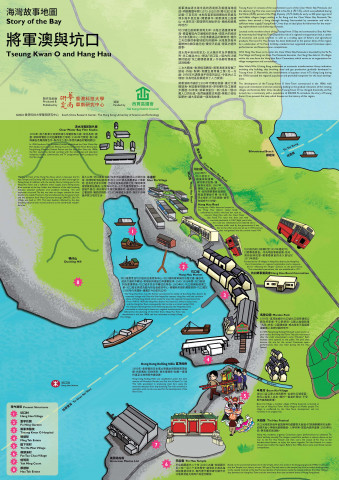Tseung Kwan O consists of the southwestern part of the Clear Water Bay Peninsula and the adjacent bay. This area was recorded in Yue Da Ji (粵大記), which was published during the Wanli (萬曆) period of the Ming Dynasty (1573-1620). As early as 300 years ago, local and Hakka villagers began settling in Sai Kung and the Clear Water Bay Peninsula. The settlers then earned a living through farming. Surrounded by mountains and with a sufficient water supply, Tseung Kwan O was thus an ideal place for fishermen for the mooring, replenishment and sheltering of vessels.
Located at the northern shore of the Tseung Kwan O Bay and connected to Shau Kei Wan by waterway, the Hang Hau Town played the role of a regional transportation hub, a center of economic and social activities as well as a trading spot of fishery and agricultural products. The local Tin Hau Temple has been dedicated to the patron deity of the region. As a celebration of Tin Hau's birthday, residents have organized annual Cantonese opera performances and flower-cannon competitions.
With Hang Hau Town as its center, the Clear Water Bay Peninsula is bounded by the Tai Po Tsai Village and Tseng Lan Shue. The Peninsula becomes the Hang Hau district. 18 villages within the area form the Hang Hau Rural Committee, which serves as an organization for village management and consultation.
After World War II, Hong Kong underwent an economic transformation. Heavy industries including ship building, ship breaking, steel and gas production gradually developed in Tseung Kwan O. Meanwhile, the establishment of squatter areas in Tiu Keng Leng during the 1950s boosted the regional population and provided manpower for the local development.
The development of the Tseung Kwan O New Town commenced in the 1980s with large-scale reclamation and town planning, leading to the gradual relocation of the existing villages and factories. After three decades, Tseung Kwan O has changed drastically and has turned into a community with a population of 400,000. To introduce the story of Tseung Kwan O, we present this map which focuses on the history of this region.
Produced & Published by
South China Research Center, The Hong Kong University of Science and Technology
Funded by
Sai Kung District Council
Request “STORY OF THE BAY”

